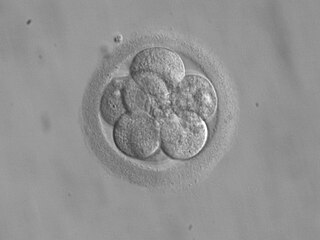Pregnancy loss is the loss of an embryo or fetus. The terms early pregnancy loss and late pregnancy loss are often used but there is no consensus over their definitions.
Abortion is the termination of a pregnancy by removal or expulsion of an embryo or fetus. An abortion that occurs without intervention is known as a miscarriage or "spontaneous abortion"; these occur in approximately 30% to 40% of all pregnancies. When deliberate steps are taken to end a pregnancy, it is called an induced abortion, or less frequently "induced miscarriage". The unmodified word abortion generally refers to an induced abortion. The most common reasons women give for having an abortion are for birth-timing and limiting family size. Other reasons reported include maternal health, an inability to afford a child, domestic violence, lack of support, feeling they are too young, wishing to complete education or advance a career, and not being able or willing to raise a child conceived as a result of rape or incest.

A multiple birth is the culmination of one multiple pregnancy, where in the mother gives birth to two or more babies. A term most applicable to vertebrate species, multiple births occur in most kinds of mammals, with varying frequencies. Such births are often named according to the number of offspring, as in twins and triplets. In non-humans, the whole group may also be referred to as a litter, and multiple births may be more common than single births. Multiple births in humans are the exception and can be exceptionally rare in the largest mammals.

Amniocentesis is a medical procedure used primarily in the prenatal diagnosis of genetic conditions. It has other uses such as in the assessment of infection and fetal lung maturity. Prenatal diagnostic testing, which includes amniocentesis, is necessary to conclusively diagnose the majority of genetic disorders, with amniocentesis being the gold-standard procedure after 15 weeks' gestation.

In human reproduction, a live birth occurs when a fetus exits the mother showing any definite sign of life such as voluntary movement, heartbeat, or pulsation of the umbilical cord, for however brief a time and regardless of whether the umbilical cord or placenta are intact. After the fetus is expelled from the maternal body it is called a neonate. Whether the birth is vaginal or by caesarean section, and whether the neonate is ultimately viable, is irrelevant.
Libertarians promote individual liberty and seek to minimize the role of the state. The abortion debate is mainly within right-libertarianism between cultural liberals and social conservatives as left-libertarians generally see it as a settled issue regarding individual rights, as they support legal access to abortion as part of what they consider to be a woman's right to control her body and its functions. Religious right and intellectual conservatives have attacked such libertarians for supporting abortion rights, especially after the demise of the Soviet Union led to a greater divide in the conservative movement between libertarians and social conservatives. Libertarian conservatives claim libertarian principles such as the non-aggression principle (NAP) apply to human beings from conception and that the universal right to life applies to fetuses in the womb. Thus, some of those individuals express opposition to legal abortion. According to a 2013 survey, 5.7/10 of American Libertarians oppose making it more difficult for a woman to get an abortion.

Selective reduction is the practice of reducing the number of fetuses in a multiple pregnancy, such as quadruplets, to a twin or singleton pregnancy. The procedure is also called multifetal pregnancy reduction. The procedure is most commonly done to reduce the number of fetuses in a multiple pregnancy to a safe number, when the multiple pregnancy is the result of use of assisted reproductive technology; outcomes for both the mother and the babies are generally worse the higher the number of fetuses. The procedure is also used in multiple pregnancies when one of the fetuses has a serious and incurable disease, or in the case where one of the fetuses is outside the uterus, in which case it is called selective termination.
In religion and philosophy, ensoulment is the moment at which a human or other being gains a soul. Some belief systems maintain that a soul is newly created within a developing child and others, especially in religions that believe in reincarnation, that the soul is pre-existing and added at a particular stage of development.
Prenatal development includes the development of the embryo and of the fetus during a viviparous animal's gestation. Prenatal development starts with fertilization, in the germinal stage of embryonic development, and continues in fetal development until birth.
"A Defense of Abortion" is a moral philosophy essay by Judith Jarvis Thomson first published in Philosophy & Public Affairs in 1971. Granting for the sake of argument that the fetus has a right to life, Thomson uses thought experiments to argue that the right to life does not include, entail, or imply the right to use someone else's body to survive and that induced abortion is therefore morally permissible. Thomson's argument has many critics on both sides of the abortion debate, yet it continues to receive defense. Thomson's imaginative examples and controversial conclusions have made "A Defense of Abortion" perhaps "the most widely reprinted essay in all of contemporary philosophy".

Neospora is a single celled parasite of livestock and companion animals. It was not discovered until 1984 in Norway, where it was found in dogs. Neosporosis, the disease that affects cattle and companion animals, has a worldwide distribution. Neosporosis causes abortions in cattle and paralysis in companion animals. It is highly transmissible and some herds can have up to a 90% prevalence. Up to 33% of pregnancies can result in aborted fetuses on one dairy farm. In many countries this organism is the main cause of abortion in cattle. Neosporosis is now considered as a major cause of abortion in cattle worldwide. Many reliable diagnostic tests are commercially available. Neospora caninum does not appear to be infectious to humans. In dogs, Neospora caninum can cause neurological signs, especially in congenitally infected puppies, where it can form cysts in the central nervous system.
Fetal rights are the moral rights or legal rights of the human fetus under natural and civil law. The term fetal rights came into wide usage after Roe v. Wade, the 1973 landmark case that legalized abortion in the United States. The concept of fetal rights has evolved to include the issues of maternal substance use disorders, including alcohol use disorder and opioid use disorder. Most international human rights charters "clearly reject claims that human rights should attach from conception or any time before birth." While international human rights instruments lack a universal inclusion of the fetus as a person for the purposes of human rights, the fetus is granted various rights in the constitutions and civil codes of several countries.
The genetics and abortion issue is an extension of the abortion debate and the disability rights movement. Since the advent of forms of prenatal diagnosis, such as amniocentesis and ultrasound, it has become possible to detect the presence of congenital disorders in the fetus before birth. Specifically, disability-selective abortion is the abortion of fetuses that are found to have non-fatal mental or physical defects detected through prenatal testing. Many prenatal tests are now considered routine, such as testing for Down syndrome. Women who are discovered to be carrying fetuses with disabilities are often faced with the decision of whether to abort or to prepare to parent a child with disabilities.
In Judaism, views on abortion draw primarily upon the legal and ethical teachings of the Hebrew Bible, the Talmud, the case-by-case decisions of responsa, and other rabbinic literature. While all major Jewish religious movements allow or encourage abortion in order to save the life of a pregnant woman, authorities differ on when and whether it is permitted in other cases.

The beginning of human personhood is the moment when a human is first recognized as a person. There are differences of opinion as to the precise time when human personhood begins and the nature of that status. The issue arises in a number of fields including science, religion, philosophy, and law, and is most acute in debates relating to abortion, stem cell research, reproductive rights, and fetal rights.
Abortion in Greece has been fully legalized since 1986, when Law 1609/1986 was passed effective from 3 July 1986. Partial legalization of abortion in Greece was passed in Law 821 in 1978 that provided for the legal termination of a pregnancy, with no time limitation, in the event of a threat to the health or life of the woman. This law also allowed for termination up to the 12th week of pregnancy due to psychiatric indications and to the 20th week due to fetal pathology. Following the passage of the 1986 law, abortions can be performed on-demand in hospitals for women whose pregnancies have not exceeded 12 weeks. In the case of rape or incest, an abortion can occur as late as 19 weeks, and as late as 24 weeks in the case of fetal abnormalities. In case of inevitable risk to the life of the pregnant woman or a risk of serious and continuous damage to her physical or mental health, termination of pregnancy is legal any time before birth. Girls under the age of 18 must get written permission from a parent or guardian before being allowed an abortion.
Prenatal sex discernment is the prenatal testing for discerning the sex of a fetus before birth.
Foeticide, or feticide, is the act of killing a fetus, or causing a miscarriage. Definitions differ between legal and medical applications, whereas in law, feticide frequently refers to a criminal offense, in medicine the term generally refers to a part of an abortion procedure in which a provider intentionally induces fetal demise to avoid the chance of an unintended live birth, or as a standalone procedure in the case of selective reduction.
Definitions of abortion vary from one source to another. Abortion has many definitions that can differ from each other in significant ways. Given the contentious nature of abortion, lawmakers and other stakeholders often face controversy in defining abortion. Language referring to abortion often reflects societal and political opinions . Influential non-state actors like the United Nations and the Roman Catholic Church have also engendered controversy over efforts to define abortion.
A termination for medical reasons (TFMR) is an induced abortion motivated by medical indications involving the fetus or mother. In some countries, health risks are the only basis for obtaining a legal abortion. Prenatal screening can allow early diagnosis, and abortion if desired or necessary. Some medical organizations advocate the offer of diagnostic testing by chorionic villi sampling, and amniocentesis to all pregnant women, as a matter of course.
Embryo loss is the death of an embryo at any stage of its development which in humans, is between the second through eighth week after fertilization. Failed development of an embryo often results in the disintegration and assimilation of its tissue in the uterus, known as embryo resorption. Loss during the stages of prenatal development after organogenesis of the fetus generally results in the similar process of fetal resorption or miscarriage. Embryo loss often happens without an awareness of pregnancy, and an estimated 40 to 60% of all embryos do not survive.